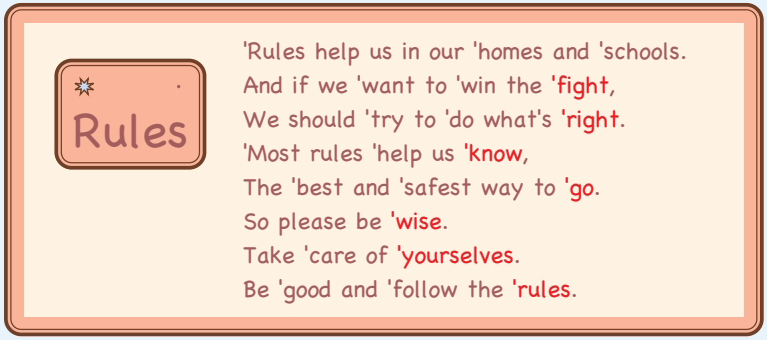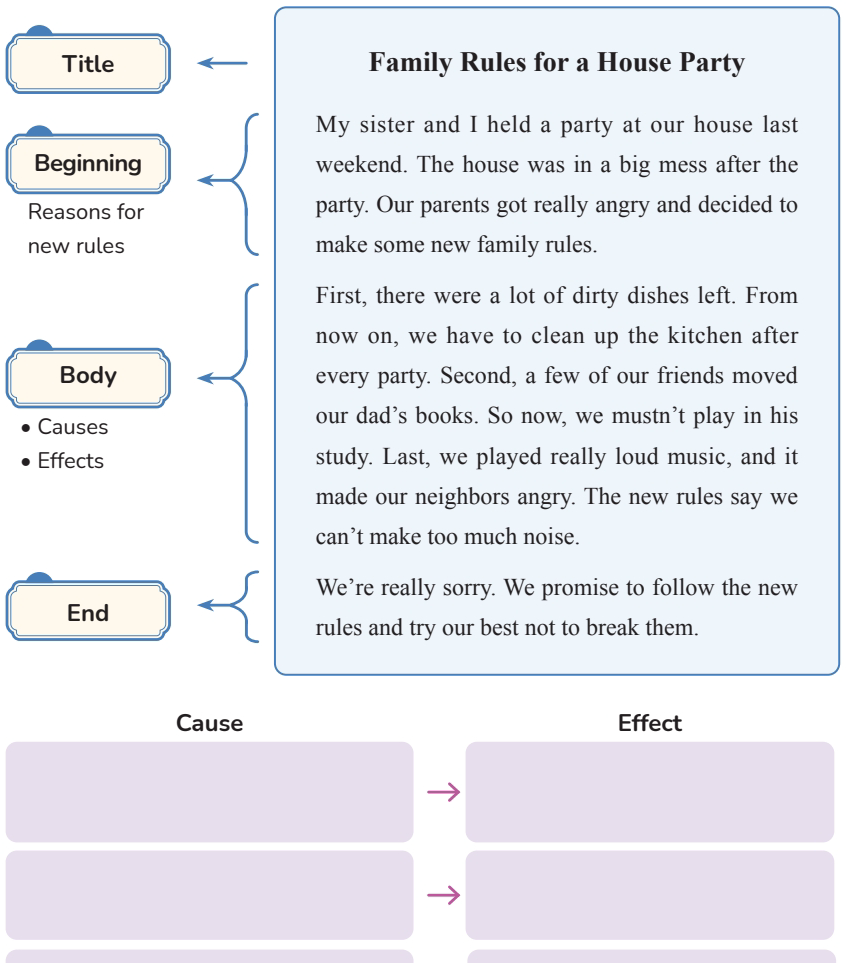一、单元目标(Big Question)
- 核心问题:Why do we need rules?
- 学习能力目标:
- 讨论规则的重要性(Talk about the importance of rules)
- 理解不同文化中的规则(Understand rules in different cultures)
- 用图表分析因果关系(Use cause-effect charts)
- 运用提问式阅读策略(Apply the “asking questions” reading strategy)
- 设计校园公共标志(Design public signs for school)
二、分模块活动详情
1. 主题引入(Preparing for the Topic)
- Activity 1: Rules around us
- Task A:将规则(交通规则、课堂规则、购物规则等)与对应场景图片匹配。
- Task B:小组讨论遵守规则的情境(如“不浪费食物”对应餐厅,“排队付款”对应商场)。
- Task C:对话练习替换关键词(e.g., “What traffic rules should we follow?” → “We should wait for green lights.”)。
2. 听说训练(Listening & Speaking)
- Activity 2:听对话为图片排序(规则相关场景)。
- Activity 3:小组讨论公共场所规则(用 “We should/shouldn’t…” 表达)。
- Function: Class rules
- 看图说班级规则(e.g., Don’t eat in class)。
- 听对话完成填空:课堂规则包括准时到校、认真听讲、禁止教室内进食、保持礼貌。
- 对话练习:用模板讨论校规(“We mustn’t run in the classroom”)。
3. 发音训练(Pronunciation)
- 目标音标:/aʊ/(loud), /oɪ/(noise), /uː/(moon), /u/(cook), /ʌ/(trouble)等。
- Activity 1-3:
- 听读含目标音标的单词(e.g., road, boy, classroom)。
- 圈出发音不同的词(e.g., “enough” vs “round”)。
- Activity 4:练习规则主题的韵律歌谣(注意重音和语调)。

4. 思维技能(Thinking Skills): 因果关系(Cause & Effect)
- Activity 1-2:
- 通过图书馆儿童读书会案例理解因果链(原因→效果)。
- 阅读交通事故文本,完成因果图:
- 原因:男孩骑车过快 + 转弯处突然出现汽车
- 结果:撞墙受伤
- Activity 3:小组讨论其他交通事故的因果链。
5. 阅读策略(Reading Strategies): 提问式阅读
- Activity 1: 读标题 “Kangkang’s Family Rules” 提出预读问题(What/Who/Why)。
- 文本内容:康康的家规(早6:30起床、及时做作业、晚上10点睡觉)。
- Activity 2: 读中/读后提问(规则细节、康康的感受、自身实践)。
- 拓展阅读 “Alone at Home”:
- 练习提问策略(e.g., “Why didn’t the child open the door?”)。
6. 主题阅读(Theme Reading): 遵守规则的好处
- Activity 1:看图讨论公共场所规则(e.g., 图书馆保持安静)。
- 文本 “Why We Follow Rules”:
- 规则三大益处:安全(遵守交规避免事故)、秩序(图书馆禁食)、公平(游戏规则增加乐趣)。
- Activity 3-4:
- 回答问题(e.g., “Why are rules important to games?”)。
- 完成因果关系图(e.g., 遵守交规→远离事故)。
- Activity 5:书信填空(关键词:keep quiet, order, environment, safety)。
三、语法重点(Grammar)
1. 反身代词(Reflexive Pronouns)
- 构成表:
| 人称代词 | I | you | she | he | it | we | you | they |
| 反身代词 | myself | yourself | herself | himself | itself | ourselves | yourselves | themselves | - 练习(Activity 3):
- Drivers should tell themselves not to break rules.(司机告诫自己)
- We learn traffic rules by ourselves.(自主学习)
2. 情态动词(Modal Verbs): must/mustn’t vs. should/shouldn’t
- 用法对比:
must:强制义务(法律/安全) → “We must follow traffic lights.”should:建议/道德义务 → “We should respect elders.”
- 练习(Activity 2-3):
- 填空:在街道应减速(should slow down),禁玩火(mustn’t play with fire)。
- 规则分类(e.g., 图书馆:should keep quiet;街道:shouldn’t play on the road)。
四、综合应用模块
1. 口语交际(Oral Communication)
- 听录音填写中山公园规则(e.g., 给垃圾箱扔垃圾、看护儿童、禁游泳/喂动物)。
- 小组讨论不同场所规则(图书馆保持安静/游泳池禁跑等)。
2. 写作训练(Reading for Writing)
- 阅读家庭派对规则,制定因果图(原因:活动混乱 → 效果:新规则)。

- 设计自定义的因果图框架(规则目的/内容/效果)。
3. 单元任务(Project): 设计校园标志
- Activity 1:
- 匹配标志功能(信息类/倡导类/警告类)。
- e.g., “No Running”标志 → 警告功能。
- Activity 2-3:小组合作设计并展示校园标志(如“保持安静”贴图)。
4. 复习与自评(Review & Self-assessment)
- 文化差异对比:
国家 特殊规则 英国 靠左行驶 新加坡 地铁禁饮食(罚款$500) 澳大利亚 儿童骑自行车须戴头盔 日本 夜间禁止骑车 - 自评表(Self-assessment):
- 兴趣度/语言能力/活动表现/合作能力/项目成果。
- e.g., “我能运用提问策略提升阅读理解” ✅
五、关键词汇与表达
| 分类 | 示例词汇 |
|---|---|
| 场所规则 | traffic rules, library rules, class rules |
| 行为规范 | keep quiet, line up, respect elders |
| 反身代词 | myself, yourself, themselves |
| 情态动词 | must (obligation), should (advice) |
此单元以“规则”为核心,整合语言训练与思辨能力培养,适合初中阶段学生深化社会规范认知。
发表回复